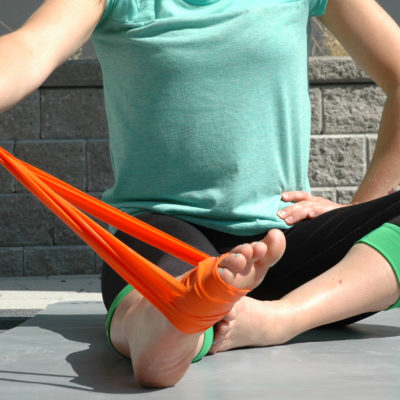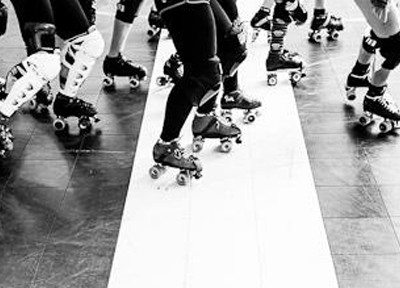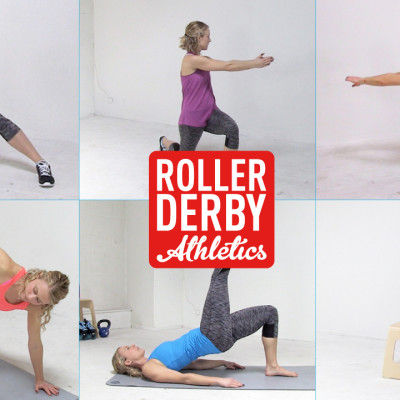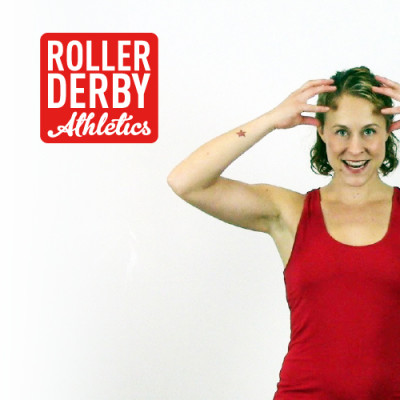Today’s video is an exercise program designed to reduce knee injuries. I’ve actually adapted this workout from a program for female soccer players, developed by the Santa Monica Orthopaedic and Sports Medicine Research Foundation. They called it PEP (prevent injury and enhance performance) and, using their program, a group of 1,435 female soccer players showed a 41% reduction in ACL injuries, which is a huge decrease!
The whole routine takes about 20 minutes start to finish, and in the soccer study they did the full routine 3 times a week for a full season. That may sound like a lot to you, but the good news is that a lot of these moves are things we really should be doing anyway as part of our derby training, to be strong and agile skaters. As long as you can incorporate some of these things into your regular routine, your knees will thank you! I have added notes in the workout below with suggestions for how to work this into your routine without adding much overall time to your week.
The PEP program consists of 5 sections: Warmup, Strengthening, Plyometrics, Agility, and Stretching. Again, things we already train for! The exercises are selected to improve strength, power, and flexibility in all the primary and stabilising muscles in your legs. I’ve adapted their moves a little bit for roller derby.
Here’s the drill…
Duration: approximately 20 minutes if you do it all at once
Equipment: stopwatch, hand towel or mini-cone
Instructions: Do each exercise for the specified number of reps or time. Be aware of proper form – keep both knees “tracking” straight over your ankles at all times – don’t let your knee cave inward (knock knees) as this is a very vulnerable position for the ACL. Land on the balls of your feet and keep your knees soft for the plyometrics section.
1. WARM UP: 90 seconds of activity – If you’re at practice, you can run on the track, do side shuffles, and run backwards. If you’re at home, run in place, do high knees, bum-kicks, and jumping jacks. Be sure to incorporate some lateral movement.
How to work it in: If you’re doing the rest of the workout after practice, then skip this part as you’ll already be warm. Time added: 0
2. STRENGTH: walking lunges – 30 seconds; single leg calf raise – 30 reps each leg
How to work it in: both of these are good exercises to do as part of your regular warmup any time you practice or work out. Time added: 0
3. PLYOMETRICS: 30 seconds each of lateral hops, front/back hops, one-foot hops, lunge jumps (feel free to take breaks in between).
How to work it in: These are also great warmup exercises before practice… or, just try to fit these in to your off-skate workouts when you can. Time added: 0-90s
4. AGILITY: *note, this part isn’t included in the video because it requires more space! I recommend incorporating some of these into your off-skate warm-ups or cool-downs at practice, or other team dryland training time. Deceleration moves are really important for building knee strength and stability.
- 3-step deceleration (1 minute). Place cones or markers at about 10 metre intervals in a straight line. Sprint to the first cone and decelerate to a stop in 3 strides. Repeat to the next cone.
- 1-2-3 cone drill (1 minute). Place 3 cones in a line about 1m apart, and stand facing the line, about 1m away from the centre cone. If the cones are numbered 1-2-3 from left to right, you’ll run to touch them in order. Step to cone 1 and touch it, then (still facing foward) return to the starting point. Repeat to cone 2, and back to the start, then cone 3, 2,1… continue in order for the minute. You’ll only need to take about 2 steps each time, but you should do it really fast! This works even better if you have a coach who can call numbers at random, and you have to run to touch the number called.
- bounding run (1 minute or 50m). Run with knees up high to your chest, taking big bounding leaps with each step. You’ll look really goofy. But it will improve your power and speed!
How to work it in: these ones take some space and some cones, but could be something your team does when you don’t have access to a track, or you add on at the end of practice. Time added: 3 minutes plus setting up cones.
5. STRETCHING: hold each stretch for 30 seconds per leg: calf, quadriceps, figure-4, inner thigh, hip flexor
How to work it in: HOPEFULLY you are already in the habit of stretching at the end of practices and workouts… So, just make sure you’re hitting these 5 in your regular routine! Time added: 0
Do these exercises faithfully, and may you never have to see the inside of an MRI machine!
xo Booty Quake
PS: leave me a comment below – what are some other injury-prone areas you would like some advice on?

 Prehab! Feet and Ankles
Prehab! Feet and Ankles  Cross-Training for Roller Derby: A Primer
Cross-Training for Roller Derby: A Primer  Stop sucking. Start winning.
Stop sucking. Start winning.  The Top Ten Exercises for Roller Derby Athletes
The Top Ten Exercises for Roller Derby Athletes  PreHab: How to Reduce Concussions
PreHab: How to Reduce Concussions
Hey there! You have so many workouts. How often would you recommend Happy Knees? Then, I’m thinking just cycle through the other ones as needed or for variety? Thanks! Keep up the good work!
The people who ran the study had their athletes do the routine 3x a week – basically as their warmup for soccer practice, from what I can tell. I think you’ll make immprovements if you add any of the movements to your regular routines / warmups / cooldowns /etc. and try to do most of the exercises on this list once a week. The other workout videos (the more intense ones) are something to do 1x or 2x a week – don’t overtrain, especially if you’re skating 3+ times a week :)
Hoy iniciaré este nueva rutina. GRACIAS :D
Another injury I would like to see some information on is tailbones. I’m not sure you can really exercise your way out of a tailbone injury but are there specific things you can do to help prevent them? Other than butt pads? I coach the new skaters and find that no one ever gets low enough (despite how many times I tell them!) And they aren’t used to skating and falling so when they fall, sometimes it’s smack on their tailbone. It’s an injury that takes a long time to recover from sometimes. Any ideas? I love your workouts and your blog posts. I keep meaning to write about the post you had (I think someone else wrote it) about skating when you’re older. I’m 47 and still on skates and still playing. A teammate and I workout every Wednesday together and always do one of your workouts. They are great.
Thanks!
Vile
Hi Vile –
Hmmm. The ol’ tailbone bruise is a bone injury not a soft tissue injury so there’s not a ton we can do to prevent that one. We teach our skaters to turn to one side when falling so they hit their butt cheek not their tailbone – of course, it’s not always possible. I think also that avoiding the backwards fall is a combination of the bend in your knees, but also your upper body posture and where your weight is placed on your skates, e.g. evenly on front and back wheels. We do not see very many tailbone injuries in our league of 100+ skaters – which makes me wonder if maybe (just a thought, not trying to throw anyone under the bus!) your local skate shop is mounting plates a little far forward or back? If everyone gets their skates from the same place, it might be something to consider. BUT I AM NOT A SKATE EXPERT! :)
Hello! I really love this training program! I tend to have soreness in my knees once we return to skating after our Dec-Jan break, so am really glad that I’ll have this as a part of my routine workout. Now I will be better prepared once we start skating again in a few weeks.
THANK YOU for providing such a comprehensive approach for this particular area!!
Gracie